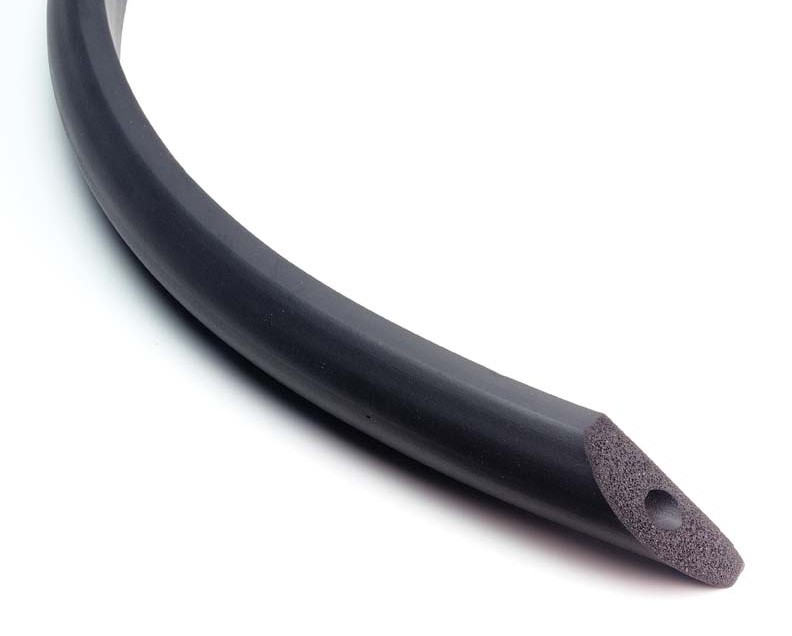
From transmission belts to window gaskets, neoprene is a multi-purpose material with a range of applications in different industries. Compared to other plastics and rubbers, this particular synthetic rubber has unique characteristics that lend themselves to specific industrial parts.
Neoprene’s properties, such as high resistance to oil, flames, and even damage caused by oxygen and ozone, make it the perfect material for a range of heavy-duty applications. Let’s break down how this particular material was invented and what makes it a useful compound for a wide variety of parts.
Where Does Neoprene Rubber Come From?
Neoprene, also known as polychloroprene or chloroprene rubber, is a synthetic rubber created from linking single molecules of chloroprene into a giant molecule. The polymer was first created successfully by American chemist Arnold Collins in 1930.
Collins was a member of Wallace Hume Carothers’s research group at the E.I. du Pont de Nemours & Company (currently DuPont Company). The research group was investigating and experimenting with divinylacetylene and its by-products. As a result, neoprene was one of the first successful synthetic rubbers to be created and marketed.
When chloroprene molecules polymerize, they link together and create polychloroprene chips. Once created, these chips are melted and combined with carbon pigments and foaming agents. When the mixture is complete, it is baked until it expands and creates neoprene sheets. These sheets are then formed into parts used in a variety of industries.
What are the Advantages of Using Neoprene?
Neoprene has specific properties that make it unique amongst the rubber and plastic choices out there. It has become one of the most widely used materials in almost all everyday products, as well as industrial ones. So what makes this synthetic material ideal for so many products? Here are the advantages it has over other materials.
Neoprene is oil-resistant
Unlike many rubbers which degrade in contact with oil or petroleum, neoprene is resistant to oils and solvents for intermittent exposure. This level of oil along with chemical resistance means the material lends itself to automotive parts which may be exposed to petroleum or oil from time to time.
Neoprene is weather-resistant
Neoprene can withstand intermittent sunlight, ozone, and weathering without degrading. These qualities makes it a great choice for outdoor applications such as door and window seals, and heavy-duty cable jackets.
Neoprene is physically tough
Perhaps the number one reason industries use neoprene in their parts is its immense physical toughness. Compared to other materials, it resists damage from flexing and twisting: it has excellent abrasion resistance, good tear resistance, and excellent resilience and rebound. This means neoprene parts last longer in heavy machinery than parts made from other plastics and rubbers.
Neoprene has a good operating temperature range
Neoprene has a low temperature range of 10° to -50°F (-12° to -46°C) and a high temperature range of up to 250°F (121°C). This temperature range makes this material ideal for most part needs outside of environments that call for extreme temperatures and other specialized needs.
When is Neoprene Not a Good Fit?
Since its creation in the 1930s, neoprene has proven itself to be the ideal material for a vast range of products used in different fields and could potentially be used in the production of many more products in the future.
Despite the benefits and advantages of neoprene, it’s not a perfect solutions for every occasion. There are some situations where a different plastic or rubber would be a better choice, such as the following criteria.
Constant oil exposure
While neoprene can withstand and resist oil exposure on an intermittent basis, it can degrade if under constant exposure to oil. In these situations, nitrile is often a better choice as it is more resistant to oil and solvent at varying temperatures than neoprene.
Extreme heat
The upper limit of neoprene’s temperature range is 250°F (121°C), which is fine for most applications. However, in situations where temperatures will regularly exceed this, an alternative material would be a better choice. Silicone is a popular choice for these types of environments, with an upper temperature limit of 480°F (250°C).
Cost
It’s important to remember that some applications can utilize many different materials. Neoprene is a very useful compound, but it may not be the most cost-effective solution depending on a part’s performance needs. Other materials, such as EPDM or natural rubber, come in with a lower price tag and may just as suitable for certain applications.
What is Neoprene Used For?
As we mentioned before, many of our everyday items are made of neoprene. Everything from scuba diving wet suits to everyday gaskets can utilize different types of neoprene. Let’s break down a few industries where this particular synthetic rubber can make a notable impact.
Automotive Industry
Neoprene is suitable for the automotive industry because of its resistance to oil and some other oxidizing agents. As a chemically inert material, neoprene has a long service life for gaskets, O-rings, and other parts by resisting hydrocarbon retrogression.
There are a variety of automotive applications that frequently used this type of rubber, including hose covers, vibration mounts, and CVJ boots. It is also used for shock absorber seals and door and window seals.
Construction Industry
The construction and industrial production industries also use neoprene for their equipment. Products like washers, deviator pads, and elevator astragals benefit greatly from resistances to oxidation, light, heat, and UV deterioration. Parts made from this material can also assist with dampening sound and vibration.
Another advantage of neoprene is that it is both water resistant and a splendid thermal and electrical insulator. Add in lightweight characteristics and a tensile of 2,500 PSI and you have a strong, versatile material for construction applications.
Wire and Cable Industry
Neoprene rubber is commonly used in wires, bulbs, electrical transformers, and cables. It usually serves as a jacket for both lead press cured mining cables and heavy-duty cables, as it does not react negatively even when exposed to high temperatures and difficult weathers. This material also offers better flame retardant and self-extinguishing characteristics than other materials, such as elastomers that are exclusively based in hydrocarbon.
Invest in the Best Material for Your Parts
The discovery and invention of neoprene were breakthroughs in manufacturing industrial parts, as well as various products used in our everyday life. However, it’s not always easy to determine which rubber or plastic compound is best for your company. That’s where Timco can help.
Our experts work directly with you to determine the perfect part solution for your performance needs and budget, whether that calls for neoprene or some other compound. Give us a call at 800-969-6242 or contact us online to talk to one of our experts or get a quote for your project.
